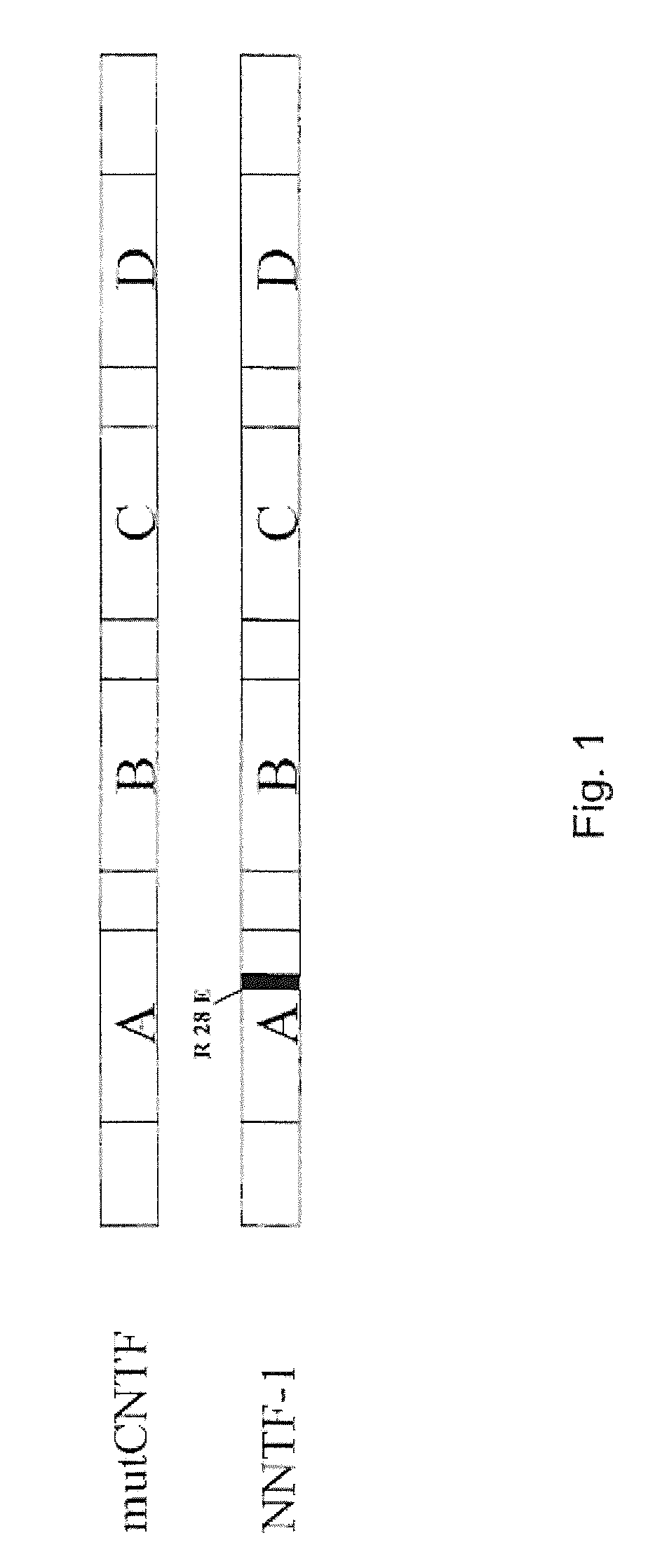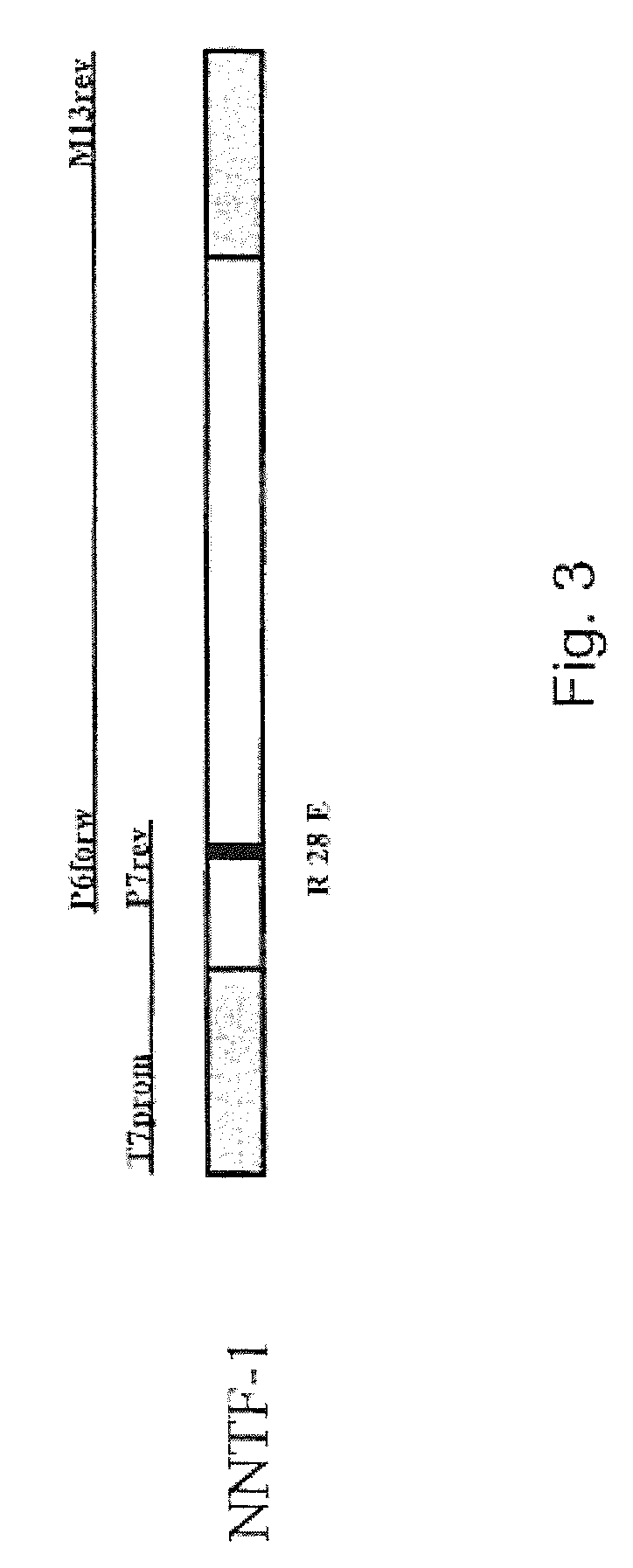Ciliary neurotrophic factor variants
a ciliary neurotrophic factor and variant technology, applied in the field of ciliary neurotrophic factor (cntf) variants, can solve the problems of cntf or cntf analog therapy, which has been proven problematic, and the induction of neutralizing antibodies against cntf observed in clinical studies is another very problematic aspect, and can jeopardize the therapeutic effect of the medicamen
- Summary
- Abstract
- Description
- Claims
- Application Information
AI Technical Summary
Benefits of technology
Problems solved by technology
Method used
Image
Examples
example 1
Generating a Point Mutation Using Splicing by Overlapping Extension (SOE)-PCR
[0060]The SOE-PCR for the generating a point mutation is performed in several steps. In addition to the terminal primers of a normal PCR, two primers are designed which are located at exactly complementary positions of the template DNA and embrace the position of the base triplet to be replaced. Thus, the template is not completely amplified, but instead is amplified in two parts, each with a terminal 5′ primer and the 3′ primer which comprises the mutation and vice versa. In this way two DNA fragments are generated which can be joined with one another in a final ligation PCR owing to their complementary ends (FIG. 3).
[0061]The amplification of the DNA was carried out according to the following scheme:
[0062]
initial denaturation95° C. / 120 s30 x denaturation95° C. / 60 sannealing55° C. / 60 sextension72° C. / 60 sfinal extension72° C. / 300 s
[0063]The ligation PCR was carried out using the following conditions:
[0064]...
example 2
Protein Expression and Purification
[0067]For protein expression of the inserts NNTF-1 and mutCNTF, which had been cloned in the expression vector pET-23a(+) (Novagen, Gibbstown, USA), the E. coli strain BL21(DE3)pLysS (Novagen, Madison, USA) was used. The expression was performed in 1 liter LB medium, wherein said medium had been previously autoclaved and a selection antibiotic had been added. In a first step, colonies of transformed bacteria were picked from an agar plate and incubated overnight in a small volume of 50 ml. Subsequently, 10 ml of this volume were transferred to the expression batch, and the batch was agitated at 180 rpm and 37° C. in an incubator until an OD600 of 0.8 was reached. Then, expression was induced with the lactose analog isopropyl S-D-thiogalactopyranoside (IPTG) in a final concentration of 1 mM. After 4 hours the batch was centrifuged for 20 minutes at 4,000 rpm and the pellets were stored at −20° C. in 50 ml centrifugation tubes until purification. The...
example 3
Determination of Activity by Use of a Proliferation Assay
[0072]The study of biological activity of NNTF-1 and mutCNTF was performed on two BAF / 3 cell lines (48), which had been transfected with the required receptor components:
Cell line: BAF / 3 IL-6R-gp130-LIFR
Origin: murine pro-B cells, stably transfected with cDNA for gp130, IL-6R, LIFR
Culturing: in suspension, DMEM+10% FCS+1% P / S, IL-6 [10 ng / ml]
Cell line: BAF / 3 CNTFR-gp130-LIFR
Origin: murine pro-B cells, stably transfected with cDNA for gp130, CNTFR, LIFR
Culturing: in suspension, DMEM+10% FCS+1% P / S, CNTF [10 ng / ml]
[0073]The cells were washed three times with sterile PBS, counted and resuspended in DMEM (+ / +) in a concentration of 5×103 / 100 μl. After addition of the respective cytokines mutCNTF or NNTF-1, 100 μl / well were each pipetted into a 96 well plate and cultured for two days with an increasing concentration series starting with 1 pg / ml and ending with 1 μl / ml cytokine. Then, the proliferation assays were performed. The cel...
PUM
 Login to View More
Login to View More Abstract
Description
Claims
Application Information
 Login to View More
Login to View More - R&D
- Intellectual Property
- Life Sciences
- Materials
- Tech Scout
- Unparalleled Data Quality
- Higher Quality Content
- 60% Fewer Hallucinations
Browse by: Latest US Patents, China's latest patents, Technical Efficacy Thesaurus, Application Domain, Technology Topic, Popular Technical Reports.
© 2025 PatSnap. All rights reserved.Legal|Privacy policy|Modern Slavery Act Transparency Statement|Sitemap|About US| Contact US: help@patsnap.com



